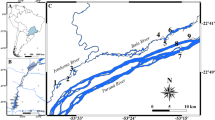Abstract
The ingestion of microplastics by marine species has been at least partially attributed to plastics emitting a dimethyl sulfide signature when exposed to marine conditions. Dimethyl sulfide, a member of the volatile organic sulfur compounds group, is an infochemical that many species rely on to locate and identify prey while foraging. Microplastic ingestion is also observed in freshwater systems; however, this study shows that the same dimethyl sulfide signature is not obtained by three common types of plastic (high-density polyethylene, low-density polyethylene, and polystyrene) in freshwater systems, suggesting that there may be an alternate mechanism driving plastic ingestion by freshwater species.

Similar content being viewed by others
References
Bentley R, Chasteen TG (2004) Environmental VOSCs—formation and degradation of dimethyl sulfide, methanethiol and related materials. Chemosphere 55:291–317
Caron F, Kramer JR (1994) Formation of volatile sulfides in freshwater environments. Sci Total Environ 153:177–194
Ginzburg B, Chalifa I, Gun J, Dor I, Hadas O, Lev O (1998) DMS formation by dimethylsulfoniopropionate route in freshwater. Environ Sci Technol 32:2130–2136
Grigsby JH, Palamand SR (1976) A colorimetric procedure for the measurement of dimethyl sulfide in water, wort, and beer. J Am Soc Brew Chem 35:43–48
Kadota H, Ishida Y (1972) Production of volatile sulfur compounds by microorganisms. Annu Rev Microbiol 26:127–138
Kiene RP, Service SK (1991) Decomposition of dissolved DMSP and DMS in estuarine waters: dependence on temperature and substrate concentration. Mar Progr Ser 76:1–11
Lehtiniemi M, Hartikainen S, Näkki P, Engström-Öst J, Koistinen A, Setälä O (2018) Size matters more than shape: ingestion of primary and secondary microplastics by small predators. Food Webs 16:e00097
Lomans BP (1999) Anaerobic versus aerobic degradation of dimethyl sulfide and methanethiol in anoxic freshwater sediments. Appl Environ Microbiol 65:438–443
Lomans BP, Smolders AJP, Intven LM, Pol A (1997) Formation of dimethyl sulfide and methanethiol in anoxic freshwater sediments. Appl Environ Microbiol 63:4741–4747
Lomans BP, Luderer R, Steenbakkers P, Pol A, van der Drift C, Vogels GD, den Camp O, H.J.M (2001) Microbial populations involved in cycling of dimethyl sulfide and methanethiol in freshwater sediments. Appl Environ Microbiol 67:1044–1051
Lomans BP, van der Drift C, Pol A, Op den Camp HJM (2002) Microbial cycling of volatile organic sulfur compounds. Cell Mol Life Sci CMLS 59:575–588
Savoca MS, Nevitt GA (2014) Evidence that dimethyl sulfide facilitates a tritrophic mutualism between marine primary producers and top predators. Proc Natl Acad Sci USA 111:4157–4161
Savoca MS, Wohlfeil ME, Ebeler SE, Nevitt GA (2016) Marine plastic debris emits a keystone infochemical for olfactory foraging seabirds. Sci Adv 2:e1600395
Scherer C, Brennholt N, Reifferscheid G, Wagner M (2017) Feeding type and development drive the ingestion of microplastics by freshwater invertebrates. Sci Rep 7:17006
Sela-Adler M, Said-Ahmad W, Sivan O, Eckert W, Kiene RP, Amrani A (2016) Isotopic evidence for the origin of dimethylsulfide and dimethylsulfoniopropionate-like compounds in a warm, monomictic freshwater lake. Environ Chem 13:340–351
Seymour JR, Simó R, Ahmed T, Stocker R (2010) Chemoattraction to dimethylsulfoniopropionate throughout the marine microbial food web. Science 329:342–345
Yoch DC, Carraway RH, Friedman R, Kulkarni N (2001) Dimethylsulfide (DMS) production from dimethylsulfoniopropionate by freshwater river sediments: phylogeny of Gram-positive DMS-producing isolates. FEMS Microbiol Ecol 37:31–37
Acknowledgements
This work was supported by an NSERC Discovery Grant (RGPIN-2015-04492) held by G. Pyle and an Alberta Conservation Association Grant in Biodiversity (RES0035325-S016) held by L. Zink. We would like to acknowledge Pyle Laboratory for Aquatic Health member Sean Everitt for his assistance in data acquisition.
Author information
Authors and Affiliations
Corresponding author
Ethics declarations
Conflict of interest
The authors declare no real or perceived conflicts of interest.
Human and Animal Rights and Informed Consent
The guidelines established by the Canadian Council on Animal Care exempt the invertebrate animals used in this study, the ethical principles set out therein were respected in the execution of this work.
Rights and permissions
About this article
Cite this article
Zink, L., Pyle, G.G. Contrary to Marine Environments, Common Microplastics in Freshwater Systems May Not Emit Dimethyl Sulfide: An Important Infochemical. Bull Environ Contam Toxicol 103, 766–769 (2019). https://doi.org/10.1007/s00128-019-02726-7
Received:
Accepted:
Published:
Issue Date:
DOI: https://doi.org/10.1007/s00128-019-02726-7




